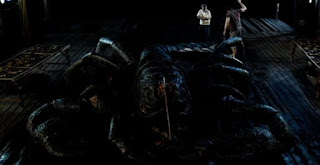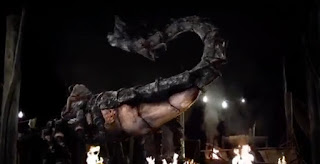 Amphibious 3D (2010)
Amphibious 3D (2010)Dir.: Brian Yuzna
Cinema 4 Rating: 4/9
There is a brief rumination on the lust for power and its connection to the sea at the beginning of Amphibious 3D which left me peeling off into my own thoughts regarding what sort of power I would want given the chance to acquire it. I am a simple man... I don't require much in the way of power, but if I could have it, I would certainly crave the means to make a far more ambitious sea monster movie than Amphibious 3D.
Amphibious 3D has an alternative title -- Amphibious Creature of the Deep -- and it was that version I certainly saw instead since my VOD rental on Amazon was only in two dimensions. While I have clearly put off seeing the film for a few years, I did have some small hopes in finally watching the film due to the participation of Brian Yuzna. For those not familiar with Stuart Gordon, Yuzna was one of the producers of Gordon's trio of Lovecraft epics -- Re-Animator, From Beyond, and Dagon -- and a director in his own right, handling the Re-Animator sequels -- Bride of Re-Animator and Beyond Re-Animator -- as well as Return of the Living Dead III, segments of Necromonicon, The Dentist and its sequel, and Faust: Love of the Damned. Yuzna's first foray into directing -- Society, from 1989 -- is a cult favorite of mine and a couple of my friends, though I will admit the film is a bit of an acquired taste. But isn't that the way of genre movie love anyway?
 |
| A type of prehistoric eurypterid. |
And I can say that it seems he has done the same here with Amphibious 3D, just to a lesser degree than usual (and without much of a sense of humor this time). Without knowing the true details of the genesis of this project, I would hazard a guess that once Mr. Yuzna found himself in Indonesia filming under the auspices of a Dutch film company (and hence the Dutch lead actress -- more on her later), he made the most of it. While Yuzna and fellow screenwriter John Penney seem to have done the final screenplay, the film is based on a story by the head of the production company, San Fu Maltha and the well-regarded science fiction writer, S.P. Somtow. I assume that Yuzna possibly saw the chance for a Southeast Asia working vacation (why not?), while also getting the opportunity to sit in the director's chair again (and once more, why not?) I would kill for such working conditions.
 |
| What the eurypterid Megalograptus looked like. |
The underwater lab adventure film DeepStar Six somewhat got this tiny specific ball rolling cinematically in 1989, supposedly portraying a particular type of eurypterid, the Megalograptus, on the loose in a wild rampage through the underwater structure that provides the film with its title. Though that version of the creature was mutated to a large degree, and given a more recognizably monstrous form (somewhat in the then nominal style of the Alien films), it was still fairly well-identified as an eurypterid in the press surrounding the film.
 Amphibious, however, seeks to up the monster ante a tad by having its eurypterid wreak havoc above the water, though technically, always still on the water itself. The bulk of the action takes place on top of a very ramshackle landing structure that rises above the surface of the water. The shack is owned by a local Sumatran smuggler and all-around creep named Boss Harris, who keeps a group of child slaves at his beck and call, mostly having them fish from the water and perform odd jobs around the structure. (Let us not muse too long upon what some of those odd jobs might be, but given the usual conditions of child slavery, some of them are likely none too savory.) Amongst the ragamuffins is a young girl named Tamal, who straps her chest down to pass as a boy, lest some of those none too savory thoughts of Boss Harris come fully blown into fruition. Tamal bears a pendant around her neck in the form of an eurypterid, and you would be right in assuming the film will play fast and loose as to whether she has any control over the titular creature or not. Or whether the creature has any control over her.
Amphibious, however, seeks to up the monster ante a tad by having its eurypterid wreak havoc above the water, though technically, always still on the water itself. The bulk of the action takes place on top of a very ramshackle landing structure that rises above the surface of the water. The shack is owned by a local Sumatran smuggler and all-around creep named Boss Harris, who keeps a group of child slaves at his beck and call, mostly having them fish from the water and perform odd jobs around the structure. (Let us not muse too long upon what some of those odd jobs might be, but given the usual conditions of child slavery, some of them are likely none too savory.) Amongst the ragamuffins is a young girl named Tamal, who straps her chest down to pass as a boy, lest some of those none too savory thoughts of Boss Harris come fully blown into fruition. Tamal bears a pendant around her neck in the form of an eurypterid, and you would be right in assuming the film will play fast and loose as to whether she has any control over the titular creature or not. Or whether the creature has any control over her.The lead character is played by Michael Pare, a long long way from Streets of Fire and Eddie and the Cruisers. He is a little more weathered, a good deal older, but still handsome and does a decent job in this film. His character, Jack Bowman, is a boat-for-hire captain who has to deal with Boss Harris and his team occasionally, though he remains fairly skeptical of the criminal's operation. Bowman has been hired by Dr. Skylar Shane, a marine biologist doing some research on prehistoric fossils in the waters. It is a good thing that sea monster or shark films are always stocked fairly well with passing marine biologists just in time for the monster to strike. Skylar Shane is played by Janna Fassaert, a Dutch actress who makes the scale move in both directions for me in terms of delivering her performance. At times she is remarkably out of her depth, but there were moments when she fit the role quite well. Dr. Shane has recently lost her daughter in a tragic accident, and so when Bowman and Shane stop by Boss Harris's landing and a terrified Tamal entreats Shane to rescue her from slavery, well, the plot has been formed.
 Well, except for the main monster. You see, it seems that when Tamal gets agitated or scared, this monstrous creature rises to the surface and does away with those that get in its way. Eventually, through a series of mishaps, miscommunications, and evil and/or deviant behavior on the part of Boss Harris and his crew, including his disgusting Irish henchman Jimmy Kudrow (played to good effect by veteran actor Francis Magee), the massively powerful giant eurypterid will attack again and again until Tamal has been freed. What this means for the innocent who get in the monster's way is exactly why we are watching this movie in the first place.
Well, except for the main monster. You see, it seems that when Tamal gets agitated or scared, this monstrous creature rises to the surface and does away with those that get in its way. Eventually, through a series of mishaps, miscommunications, and evil and/or deviant behavior on the part of Boss Harris and his crew, including his disgusting Irish henchman Jimmy Kudrow (played to good effect by veteran actor Francis Magee), the massively powerful giant eurypterid will attack again and again until Tamal has been freed. What this means for the innocent who get in the monster's way is exactly why we are watching this movie in the first place.And then there is my Pet Peeve of the Week, one of those things that you see a lot (in slight variances) in monster films, usually a move so inexplicable that it just really starts to gnaw at me. In this case, it is the use of the creature's tail as an all-seeing, all-knowing device that the monster employs much like the periscope devices on the top of the flying saucers in the original 1953 film of The War of the Worlds. The creature's tail will be used in a place, such as through a floor or into another room, where the eurypterid can clearly not see what is going on, and then the tail reacts like it had a pair of eyes on it. Now, I am all for setting up for us that perhaps there are sensory organs on the creature's tail (or whatever appendage is being deployed to move about in such a way) that allow to weave in or around objects in pursuit of prey or revenge or whatever the monster is doing. But you have to set that up for us!
 We see this time and again when films have a giant octopus or squid character, where every separate tentacle acts as if it has "Spidey sense". Whether it is Harryhausen's octopus (actually, as the Master termed it during the making of the film, a "sixtopus," since they only had the budget to animate six arms) that attacks the Golden Gate Bridge in It Came from Beneath the Sea, the mini-series of Peter Benchley's The Beast, or the massive Kraken in Disney's Pirates of the Caribbean films, each one has an animal whose tentacles seem to be acting independently of actual line of sight on the part of the creature, and are able to anticipate the moves of their victims with stunning precision. Sometimes the tentacles even seem to have personality of their own. Not always, but quite often enough to really be a thorn in my side, even in films that I really enjoy or are meant as nothing more than mere B-movie fodder.
We see this time and again when films have a giant octopus or squid character, where every separate tentacle acts as if it has "Spidey sense". Whether it is Harryhausen's octopus (actually, as the Master termed it during the making of the film, a "sixtopus," since they only had the budget to animate six arms) that attacks the Golden Gate Bridge in It Came from Beneath the Sea, the mini-series of Peter Benchley's The Beast, or the massive Kraken in Disney's Pirates of the Caribbean films, each one has an animal whose tentacles seem to be acting independently of actual line of sight on the part of the creature, and are able to anticipate the moves of their victims with stunning precision. Sometimes the tentacles even seem to have personality of their own. Not always, but quite often enough to really be a thorn in my side, even in films that I really enjoy or are meant as nothing more than mere B-movie fodder.And here, too, we get the eurypterid and its magical all-knowing tail. And a full-on land scorpion's tail too, not the very different water scorpion type. The monster really seems to be more of a cross between a lobster and a land scorpion, and it was hard for me at times to believe it was anything but that. Still, this is a completely fantastical concept, and if one is to be believe in the monsters they are seeing on screen, sometimes one has to accept that perhaps a movie monster is not going to look exactly as one would wish or prefer. Come in expecting a true to life eurypterid, it is going to be much smaller, and you won't get many scares. Come in expecting a monstrous eurypterid that has been designed with attachments that you weren't envisioning, and you might have a fun time. Besides, monster movies often have so many other hurdles to overcome: bad scripts, subpar acting abilities on the part of the cast, low budgets; they should at least be able to get by on the notion that if they can at least make the monster look pretty cool and scary, then maybe that will be all the audience needs to accept the film. And I do have to admit that, at times, the monster is kind of cool-looking here.
 Amphibious is a film that nearly comes together for me, but not quite, though I cannot completely write it off as unenjoyable and rote. But neither can I consider it a truly good film and worthy of future likely re-watching (though I have just watched it twice, out of necessity, in recent days). Yuzna does a decent job in moving things along and the direction is mostly tight, but the whole affair is laden with an overall cheapness -- mostly marked by being a deep water creature film where we never get a scene in the deep of the water -- that it can never really escape. I decried the film at the beginning of this piece for its lack of ambition, and it is sad that it doesn't try to do more with its setting. But neither is it completely unambitious; the angle built around the connection between the biologist and Tamal is an interesting one that has a somewhat surprising climax, though I wish the film had gone deeper in this direction. The film's chief asset is the location shooting and hiring of local actors (limitations of talent set aside), allowing us a chance to see a film that is, for once, not fully populated by boring, bickering, white American teenagers. If there is one thing I am tired of in modern film, it is boring, bickering, white American teenagers.
Amphibious is a film that nearly comes together for me, but not quite, though I cannot completely write it off as unenjoyable and rote. But neither can I consider it a truly good film and worthy of future likely re-watching (though I have just watched it twice, out of necessity, in recent days). Yuzna does a decent job in moving things along and the direction is mostly tight, but the whole affair is laden with an overall cheapness -- mostly marked by being a deep water creature film where we never get a scene in the deep of the water -- that it can never really escape. I decried the film at the beginning of this piece for its lack of ambition, and it is sad that it doesn't try to do more with its setting. But neither is it completely unambitious; the angle built around the connection between the biologist and Tamal is an interesting one that has a somewhat surprising climax, though I wish the film had gone deeper in this direction. The film's chief asset is the location shooting and hiring of local actors (limitations of talent set aside), allowing us a chance to see a film that is, for once, not fully populated by boring, bickering, white American teenagers. If there is one thing I am tired of in modern film, it is boring, bickering, white American teenagers.As to the main reason for watching one of these films, the special effects are, for the most part, fairly well done, and in some shots, far better than I had reason to expect. There is the usual problem in CGI effects where you often get no real sense of the creature's weight and mass, and of it reacting naturally to objects around it, but that is an ongoing battle that I have had with this style of effect since the beginning. Here, it hardly matters, for the full battle against the creature that takes up the back portion of the film is mostly well staged and a definite step above the type of ultra low-grade effects proffered by Syfy Channel films. Compared to those, Amphibious is almost a masterpiece of high ambition.
RTJ




No comments:
Post a Comment